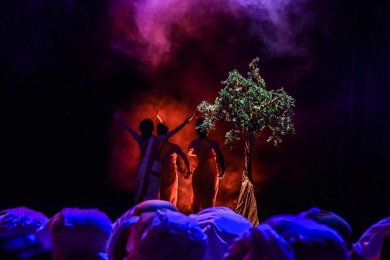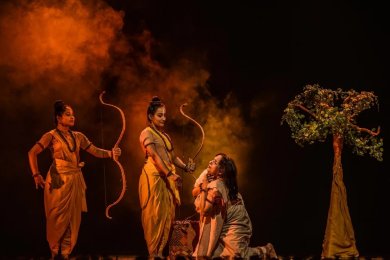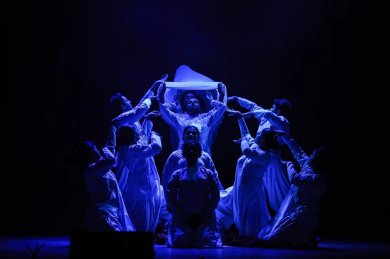
|   |

|   |
 e-mail: ukb7@rediffmail.com Holding a legacy aloft Photos courtesy: Mamata Shankar November 24, 2016 The story goes that the virtuoso dancer Uday Shankar -- a debutante in London in the 1920s -- was presented, one evening, a Nataraja sculpture. Awestruck by the statuette and gazing intently upon the figure, he could not sleep the whole night. By the time the first sunrays struck the London mist, the insomniac artiste began getting the vibes into his dancer’s limbs: the body-dynamics that could possibly lead on to the divine stance and the aesthetic gestures that could flow out from it. The early Shankar was like that: a complete natural, honed more by Indian iconography and Rajput miniatures, and drawing sustenance from intuition and exposure, than ever groomed by a hard-core training regimen. Then in 1938, he made India his base, and established the ‘Uday Shankar India Cultural Centre’ at Simtola (3 km from Almora) in the Himalayas, inviting Sankaran Namboodri for Kathakali, Kandappa Pillai for Bharatanatyam and Amobi Singh for Manipuri (besides Ustad Allauddin Khan for music). There evolved the famous Uday Shankar style of dance as a fruit of collaboration among the assembled masters. But the centre dissolved in 1942 – due to paucity of funds – and there never was a composite grammar formalized around his total approach. 

Sabari
Sabari, a dance-drama premiered recently by Udayan Kala Kendra, the
dance institution of Mamata Shankar Dance Company from Kolkata, was a
handiwork that used the best of the Shankar ethos under the competent
scripting, choreography, costumes and direction of his gifted daughter,
Mamata Shankar. Drawing from the Ramayana legend of Sabari – whose
proverbial long wait for the incarnation of Rama is well-remembered in
Indian literature – Mamata drew an entirely believable pen-portrait of
the innocent tribal girl brought up within folk traditions of music and
dance, selected for a happy wedlock, but suddenly repulsed by the
violence against animals by the groom’s family. She strays into the
hermitage of sage Matanga and – despite stiff opposition from the
orthodox brahmacharis present – eventually endears herself to everyone
by her selfless service and ardent devotion to the rituals. After the
sage’s demise, she patiently awaits Rama’s arrival through many decades.
At last at the appointed hour, Rama appears, when the old and emaciated
Sabari dotes on the banished Ikshvaku prince, feeds him to her heart’s
content and happily breathes her last on his blessed lap. Choreography
stressed on simple story-telling, with mythology-savvy attires and
support of only non-verbal music, sans dialogue.Amritasya Putra, presented by the same troupe on the following evening, was based on an abstract theme this time, while still using instrumental music. Again conceived and directed by Mamata Shankar in her father’s footsteps, the dance-drama was unfolded in a few stages. Initially, there was the genesis of human beings from the five primordial elements: fire, earth, water, air and space, followed by trials and turmoil all around. Then came the evolution in role playing, with Mamata as a doting mother to visualize unstinted, filial love. This was followed by growth of innocent camaraderie, using folk idioms like garba, ghumar and dandia ras. Next in evolution was gentle, amorous love among the male and the female, before it all degenerated into ignorance and delusion, lust and greed, desire and hatred, anger and violence. Creepy creatures appeared on stage, black theatre stepped in and soon there was chaos all over, descending into the pits of universal pain and suffering. Finally came redemption and, like a phoenix rising from the ashes, man’s inner quest asserted his ultimate truth behind the mortal existence. 

Amritasya Putra
From the two radically different approaches, the stylistic elements –
going all the way back to Uday Shankar - that came through were: one,
neutral attitude to gravity, neither thumping earth nor leaping in
defiance; two, strong recognition of contrasts: horizontal extensions
and contractions, vertical rises and falls; three, copious use of solar
plexus: breathing deeply in and out; four, sinuous spatial movements of
upper and lower torsos; five, intimate use of both floor and higher
levels; six, diagonal glances and head-tilts; seven, rejection of
anklets; and, eight, ample regard for elegant showmanship.Kudos to Mamata for letting us probe into the creative mind of an icon.  Dr. Utpal K Banerjee is a scholar-commentator on performing arts over last four decades. He has authored 23 books on Indian art and culture, and 10 on Tagore studies. He served IGNCA as National Project Director, was a Tagore Research Scholar and is recipient of Padma Shri. Post your comments Please provide your name and email id when you use the Anonymous profile in the blog to post a comment. All appropriate comments posted with name & email id in the blog will also be featured in the site. |